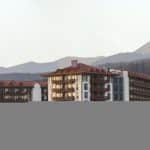When we think of real estate development, the images that often come to mind may be of urban landscapes, tall buildings, and bustling city scenes. However, what if we told you that conservation and real estate development could seamlessly intertwine? With the right approach, it’s entirely possible to design and develop projects that not only coexist with but actively support local ecosystems and wildlife. The key lies in conservation-focused landscaping – a practice rooted in thoughtful design, ecological understanding, and a commitment to biodiversity.
The Intersection of Urban Development and Conservation
The rise of urban development has brought about significant changes in landscapes across the world. With the increasing urbanization, natural habitats have been altered or destroyed, leading to a decrease in biodiversity and an increase in environmental problems. Meanwhile, the need for urban development, especially in the real estate sector, continues to grow. This presents a complex challenge but also an opportunity to rethink how we approach urban development projects.
Cela peut vous intéresser : How Can Real Estate Development Balance Economic Growth with Environmental Sustainability?
Conservation-focused landscaping serves as a bridge between the urban and natural world. This approach integrates elements from the local ecosystems into the development projects, preserving indigenous species, and maintaining the ecological balance. By doing so, it ensures that the habitat of local flora and fauna is not just preserved, but actively nurtured.
Conserving Water through Intelligent Design
Water is a vital resource for all life, and its conservation is a crucial part of any sustainable development project. With conservation-focused landscaping, the use of water can be optimized and wastage minimized. This is achieved through intelligent design strategies such as installing efficient irrigation systems, using native plant species that require less water, and incorporating rainwater harvesting systems.
A découvrir également : What innovative solutions can be used to create flexible and modular interior designs in real estate developments for adaptable use?
Incorporating bodies of water into a project can also help support local fish species and other aquatic organisms. This not only adds to the biodiversity of the area but also creates aesthetically pleasing landscapes.
Building Green Spaces that Support Biodiversity
Green spaces play a vital role in urban areas. They serve as the lungs of the city, absorbing carbon dioxide and releasing oxygen. They also provide a habitat for a wide range of species, contributing to biodiversity. For these reasons and more, green spaces should be an integral part of any development project.
By choosing native plant species for these spaces, you can ensure that they are suited to the local climate conditions and soil types. These species are also more likely to attract local wildlife, contributing to biodiversity.
The Role of Technology in Conservation Landscaping
Technology can play a significant role in conservation-focused landscaping. For instance, Google Scholar and WorldCat can be used to access academic resources on local ecosystems, species, and best practices for their conservation. Satellite imagery and GIS (Geographic Information System) can be used for mapping and planning purposes, helping to identify areas of ecological importance that should be preserved.
Tech tools can also be used for monitoring and maintenance purposes. For instance, sensors can be installed to monitor soil moisture levels, irrigation systems can be automated, and drones can be used to keep an eye on the health of green spaces.
Restoring and Preserving the Natural Landscape
Conservation-focused landscaping is not just about preserving the natural environment, but also restoring it where necessary. Many development projects are built on land that has previously been degraded due to factors such as pollution, erosion, or previous construction projects.
In such cases, restoration efforts can be undertaken to bring the land back to its natural state. This can involve tasks such as soil remediation, planting of native species, and rehabilitation of water bodies. By doing so, it’s possible to create a thriving ecosystem on land that was previously considered unusable.
By integrating conservation-focused landscaping into real estate development projects, we can create spaces that not only meet our needs but also support the local ecosystems and wildlife. This approach highlights the potential for harmonious coexistence between urban development and nature, offering a blueprint for the sustainable development projects of the future.
Capitalizing on Vacant Land for Conservation
With the increasing urbanization, there are often plots of vacant land that remain undeveloped. These areas, though seemingly insignificant, hold great potential for conservation-focused landscaping. With thoughtful planning and execution, vacant lands can be transformed into thriving ecosystems that support local biodiversity.
Using academic resources, such as Google Scholar and Oxford Academic, developers can gain insights into the existing local ecosystems and the species that inhabit them. This can guide the design process, ensuring that the new landscaping incorporates elements that support these species, be it fish, wildlife, or plant species. These vacant lands can be designed to replicate natural habitats, offering refuge and resources for local wildlife.
Green infrastructure, such as parks, community gardens, and green roofs, can be installed on these vacant lands. Not only do these spaces improve the aesthetic appeal of urban areas, but they also offer numerous environmental benefits. For instance, they improve air and water quality, reduce urban heat island effect, and provide ecosystem services such as pollination and pest control.
Moreover, these spaces can serve as vital links in landscape connectivity. By linking different habitats together, they enable wildlife species to move freely across the urban landscape, enhancing their survival prospects and contributing to biodiversity conservation. This is especially vital in the United States, where rapid urban development often fragments wildlife habitats.
Conclusion: Creating Harmony between Built Environment and Nature
The notion of real estate development being at odds with nature is increasingly becoming outdated. With conservation-focused landscaping, we can create built environments that not only coexist but thrive alongside the natural world. Whether it’s the restoration of degraded land, the intelligent use of water, or the development of vacant land, every aspect of a project can be designed with conservation in mind.
By utilizing resources like Google Scholar, WorldCat, and Oxford Academic, developers can access a wealth of knowledge to inform their design strategy. The use of technology such as GIS mapping and automated systems can further enhance the efficiency and effectiveness of conservation efforts.
The result? Urban developments that are not only visually appealing but also rich in biodiversity and beneficial to the environment. Whether it’s the hum of bees in the community garden, the sight of fish in the restored water body, or the rustling of leaves in the park, these developments can offer a slice of nature amidst the hustle and bustle of urban life.
In conclusion, conservation-focused landscaping is more than just a trend. It’s a shift towards a more sustainable and holistic approach to real estate development. One that takes into account the needs of both humans and wildlife, and understands the importance of protecting our natural resources. By adopting this approach, we are not just developing properties, but nurturing ecosystems, fostering biodiversity, and contributing to a healthier planet. It’s a win-win situation for all – the people, the wildlife, and the environment.











